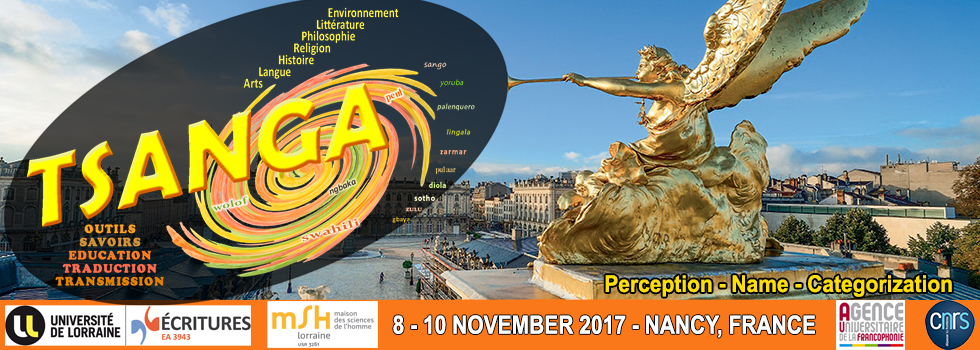
Call for papersInternational Conference Call for papers Perception and denomination, categorization of the notion of colour"Methodology of action, vision, perception, cognition""Light and / or tint, denominations and complex realities in its diversity"
8-9-10 November 2017- MSH Lorraine-Nancy
Organized within the framework of the "Rendez-vous du TSANGA""Transmissions of Knowledge and Numerical Appropriation of African Generations"
According to Locke, colour is a second quality of the thing. He denounces here the illusory and tenacious nature urging human beings to consider that the thing is really of its colour. On the contrary, colour is a subjective construction. It depends on the human’s physiological and cognitive constitution. Admittedly, once the quasi-universality of the organization of the human eye is recognized, the colour subjectively given to objects seems to be firmly linked to the physicochemical action by wavelengths on the cones in the retina. However, the cognitive processes of perception are too complex and integrative to guarantee a strict reduction between the physiologically seen and the cognitively perceived. A culturalist approach is then needed to understand how the perception of colour can be built beyond physiology. We will not speak about what is medically classified as perception disorder, but rather about how the fact of being a member of a culture can influence, or even build the perception of colours. Thus, following Michel Pastoureau’s reflections according to which "more than nature, pigment, eye or brain, it is society that" makes "colour, which gives it its definition and meaning, which declines its codes and values, which organizes its practices and determines its stakes "(2015, P. 240), a general challenge would be to understand how colour - and especially hue - could have emerged in the Western world as a primary notion to describe the strictly visual appearance of the world, whereas the notion of intensity could also have imposed itself. The generalist approach to these questions is not devoid of any perspective. If it is true that the western print has imposed some of its knowledge, practices or values on the daily life of countries in the Global South with the creation and integration of new vocabulary, The 1st TSANGA Meeting issue is to lay the foundations of a reflection which aims to deconstruct or, conversely understand the idea that most African cultures did not perceive and / or still do not perceive the colour by the colour shade but by other functioning modalities. For some sub-Saharan African cultures, the essential point is not to know if the colour is red, green, but to know whether it was dry or wet, striped or spotted, smooth or rough, soft or hard, dark or clear, deaf or sound, Colour can be apprehended together with other sensory phenomena. This difficult question is conditioned by the specific context of the African continent as in other non-westernized cultures in the world. It hardly seems to encompass a homogeneous culture. It may be thus appropriate to ensure that the culturalist approaches are mixed with an ecologic approach of perception as formulated by James J. Gibson. On the linguistic, ethnolinguistic and sociolinguistic level, if we adopt the denomination of tones and the shades in tones in the Western culture, can we still recognize true, classifiable colours? Similarly, is it possible and seems essential:
As the purpose of the "Rendez-Vous" is essentially methodological, the conclusions of the meeting could enable the "new" Africanist researchers to invest this field of study in a transdisciplinary perspective. Finally, the topic of the “colour”, due to its capacity to federate several research fields, offers a space of reflection and an opportunity to compare approaches in field research, languages, literature and arts. Thus, through this theme, we will try to examine the origin of learning and educational techniques, the transformation of social organization modes, the integration and development of these cultures in the current environment. This first meeting aims to be the first step which can enable the following things to happen during the next “Rendez-vous”:
The organizing committee wishes to receive submissions for communication or participation to a workshop (Friday 10, 2-5pm) which address the theme of the conference from one of the following angles :
Abstract Submission Deadline : 20 may 2017 Submit your abstract of no more than 250 words (a reply to your proposal will reach you before 5 June) The French language would be preferred but English is acceptable as well (slides in French please) in pdf version : call for papers As part of the action research of the TSANGA project, all the presentations will be filmed and the visual aids of the project will have to be particularly accurate. They will constitute for the multidisciplinary teams living in a country from the Global South participatory tools of work for the project and educational data for their students.
Contact Information: Sylvie Grand’Eury-Buron, Erick Cakpo, Bruno Trentini
|

